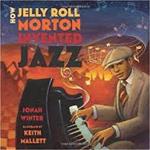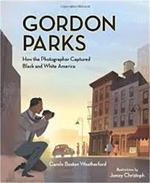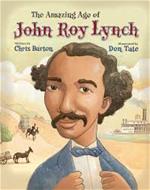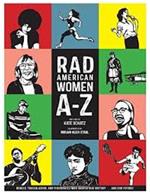We often turn young readers to biographies to find role models and a rich source of inspiration. However, we should be sure to share biographies that feature diverse historical figures. It’s important to consider who is being overlooked, whose stories have been neglected, and why certain subjects are favored. The members of the Children’s Literature and Reading Special Interest Group present new biographies that cross boundaries, raise complex questions, and highlight unsung heroes.
Ages 4–8
How Jelly Roll Morton Invented Jazz. Jonah Winter. Ill. Keith Mallett. 2015. Roaring Brook Press.
 Jelly Roll Morton claims to have invented jazz in 1902. In this biography, readers are invited to learn about his early life, whether or not the claim is true, and the nature of jazz itself. The narrative is presented playfully with repeated phrases (“let’s say”) and text variations in the forms of songs and recipes. The rich blues and oranges in the illustrations add to the liveliness and celebratory feel of the book. A lengthy and informative author’s note is included, but only minimal references and discography.
Jelly Roll Morton claims to have invented jazz in 1902. In this biography, readers are invited to learn about his early life, whether or not the claim is true, and the nature of jazz itself. The narrative is presented playfully with repeated phrases (“let’s say”) and text variations in the forms of songs and recipes. The rich blues and oranges in the illustrations add to the liveliness and celebratory feel of the book. A lengthy and informative author’s note is included, but only minimal references and discography.
Gordon Parks: How the Photographer Captured Black and White America. Carole Boston Weatherford. Ill. Jamey Christoph. 2015. Albert Whitman and Company.
 This biography joins the handful of picture book treatments of photographers such as Ansel Adams, Wilson Bentley, and Dorthea Lange. While biographies of both artists and activists have become more abundant, this appears to be the first book for children about Gordon Parks. The tone is matter of fact, chronicling personal tragedies and addressing historical inequality. The replicas of Parks’ photographs in the illustrations are especially engaging. The back matter includes some sample photographs and an author’s note, but lacks a timeline and bibliography.
This biography joins the handful of picture book treatments of photographers such as Ansel Adams, Wilson Bentley, and Dorthea Lange. While biographies of both artists and activists have become more abundant, this appears to be the first book for children about Gordon Parks. The tone is matter of fact, chronicling personal tragedies and addressing historical inequality. The replicas of Parks’ photographs in the illustrations are especially engaging. The back matter includes some sample photographs and an author’s note, but lacks a timeline and bibliography.
Ages 9–11
The Amazing Age of John Roy Lynch. Chris Barton. Ill. Don Tate. 2015. Eerdman’s Books for Young Readers.
 The striking cover illustration of the subject of this biography captures the warmth and honesty readers will encounter inside the book. The appealing illustrations, full of close-ups of faces and details of the historical context, drive the story and will engage readers. The narrative presented carefully balances Lynch’s personal journey with the larger political issues of the time period. The story is quite long, covering a lot of historical ground from slavery through reconstruction and beyond, but plenty of humor and drama in both the art and the text keep the story flowing. The back matter continuesthe story with a historical note, highly detailed timeline, further reading, and author and illustrator notes.
The striking cover illustration of the subject of this biography captures the warmth and honesty readers will encounter inside the book. The appealing illustrations, full of close-ups of faces and details of the historical context, drive the story and will engage readers. The narrative presented carefully balances Lynch’s personal journey with the larger political issues of the time period. The story is quite long, covering a lot of historical ground from slavery through reconstruction and beyond, but plenty of humor and drama in both the art and the text keep the story flowing. The back matter continuesthe story with a historical note, highly detailed timeline, further reading, and author and illustrator notes.
Ages 12–14
Enormous Smallness: A Story of E.E. Cummings. Matthew Burgess. Ill. Kris Di Giacomo. 2015. Enchanted Lion Books.
 The book offers good advice for students who may tend to get frustrated or are unmotivated: “Anything is possible, as long as you are true to yourself and never give up, even when the world seems to say, stop!” Burgess begins the biography by painting a quick picture of Cummings’ life at the point in which the story eventually ends. Then he nicely flows into where his love for writing poems began. The story walks through his life, but it specifically focuses on what really impacted his writing career. It introduces different people in his life, and throughout the book he explains the roles that they played in his writing career: “Some people criticized him for painting with words. Others said his poems were too strange, too small.” It does not illustrate just the positive aspects of Cummings’ life, but also the hardships of his writing career.
The book offers good advice for students who may tend to get frustrated or are unmotivated: “Anything is possible, as long as you are true to yourself and never give up, even when the world seems to say, stop!” Burgess begins the biography by painting a quick picture of Cummings’ life at the point in which the story eventually ends. Then he nicely flows into where his love for writing poems began. The story walks through his life, but it specifically focuses on what really impacted his writing career. It introduces different people in his life, and throughout the book he explains the roles that they played in his writing career: “Some people criticized him for painting with words. Others said his poems were too strange, too small.” It does not illustrate just the positive aspects of Cummings’ life, but also the hardships of his writing career.
Ages 15+
The Boys Who Challenged Hitler: Knud Pedersen and the Churchill Club. Phillip Hoose. 2015. Farrar, Straus, & Giroux.
 The resistance movement in Denmark during WWII has been treated in children’s novels like Number the Stars and pictures books like The Yellow Star. Hoose’s new book tells the story of the genesis of that movement. Two teenage brothers find themselves appalled with their country’s leader and the community around them when the Nazi occupation begins. Knud Pedersen may only be 15 but, with the help of his brother and a cadre of friends, he goes on the attack against the German occupiers. Teen readers will be on the edge of their seat as they learn of Pedersen’s bravery and activism. Hoose balances his voice with that of Knud’s, whom he interviewed and corresponded with in order to write the book. This is an exemplary piece of nonfiction with ample back matter.
The resistance movement in Denmark during WWII has been treated in children’s novels like Number the Stars and pictures books like The Yellow Star. Hoose’s new book tells the story of the genesis of that movement. Two teenage brothers find themselves appalled with their country’s leader and the community around them when the Nazi occupation begins. Knud Pedersen may only be 15 but, with the help of his brother and a cadre of friends, he goes on the attack against the German occupiers. Teen readers will be on the edge of their seat as they learn of Pedersen’s bravery and activism. Hoose balances his voice with that of Knud’s, whom he interviewed and corresponded with in order to write the book. This is an exemplary piece of nonfiction with ample back matter.
Rad American Women A-Z: Rebels, Trailblazers, and Visionaries Who Shaped our History…and our Future. Kate Schatz. Ill. Miriam Klein Stahl. 2015. City Lights Books.
 This book for all ages features 25 women who made a difference, women readers young and old should know all about, and women who all deserve more than the one page dedicated to them in this book. While some of the names will be familiar to readers (Rachel Carson and Carol Burnett), many will stand out as new and unknown (Jovita Idar, the Grimke sisters, Yuri Kochiyama). Energy and enthusiasm pervade the text and art in this book; each woman featured gets a byline (“who reminds us to bravely claim our true identity,” “who shows us the power of a brilliant mind,” “who led her people with strength and courage”), a cut-paper portrait against a bright background, and a page of biographical information. The back matter is as engaging as the individual treatments, featuring “26 things you can do to be rad” and plenty of resource material.
This book for all ages features 25 women who made a difference, women readers young and old should know all about, and women who all deserve more than the one page dedicated to them in this book. While some of the names will be familiar to readers (Rachel Carson and Carol Burnett), many will stand out as new and unknown (Jovita Idar, the Grimke sisters, Yuri Kochiyama). Energy and enthusiasm pervade the text and art in this book; each woman featured gets a byline (“who reminds us to bravely claim our true identity,” “who shows us the power of a brilliant mind,” “who led her people with strength and courage”), a cut-paper portrait against a bright background, and a page of biographical information. The back matter is as engaging as the individual treatments, featuring “26 things you can do to be rad” and plenty of resource material.
Lesley Colabucci is an associate professor at Millersville University in Pennsylvania, where she teaches courses in children’s/adolescent literature. She is currently serving on NCTE’s Award for Excellence in Poetry for Children.
These reviews are submitted by members of the International Literacy Association's Children's Literature and Reading Special Interest Group (CL/R SIG) and are published weekly on Literacy Daily.